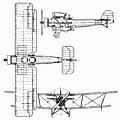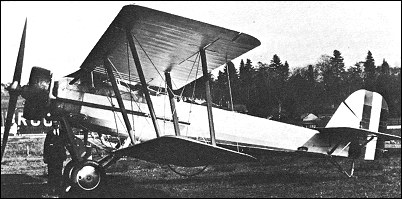|
| The Vickers Type 113 Vespa Mk I
first flown in September 1925 was built as a private venture to the requirements of Air Ministry Specification 30/24 for an army cooperation aircraft. An unequal-span well-staggered biplane with tandem open cockpits, it was powered as first flown by a Bristol Jupiter IV radial; the Vespa was underpowered with this engine, which was then replaced by a 339kW Jupiter VI. After being damaged in an accident during June 1926 it was rebuilt with wings of metal basic structure and redesignated Type 119 Vespa Mk II but, although tested successfully, it was not ordered for the RAF. However, six Type 149 Vespa Mk III aircraft with a number of airframe refinements were supplied to
Bolivia during 1929, in which year four aircraft with 365kW Armstrong Siddeley Jaguar VIC engines were ordered for the Irish Army Air Corps and designated Type 193 Vespa Mk IV, four more aircraft with some improvements subsequently being built for Ireland as the Type 208 Vespa Mk V. During 1930 the Vespa Mk II was modified to a standard similar to the Irish Vespa Mk IVs and, powered by a 395kW Bristol Jupiter VIIF engine, became designated Type 210 Vespa Mk VI. It was used for demonstrations in China, but on return to the UK was modified yet again, and with a Bristol Pegasus 'S' supercharged engine installed was redesignated Type 250 Vespa Mk VII, being used on 16 September 1932 to establish a new world altitude record of 13404m. Following that it was acquired by the Air Ministry and used by the RAE for high-altitude research.
 | A three-view drawing (800 x 802) |
| CREW | 2 |
| ENGINE | 1 x 400hp Bristol Jupiter IV |
| WEIGHTS |
| Take-off weight | 18 kg | 40 lb |
| Empty weight | 1120 kg | 2469 lb |
| DIMENSIONS |
| Wingspan | 15.24 m | 50 ft 0 in |
| Length | 9.53 m | 31 ft 3 in |
| Height | 3.12 m | 10 ft 3 in |
| Wing area | 52.12 m2 | 561.01 sq ft |
| PERFORMANCE |
| Max. speed | 203 km/h | 126 mph |
| Ceiling | 6187 m | 20300 ft |
| ARMAMENT | 2 x 7.7mm machine-guns |
| grahamclayton, e-mail, 07.05.2023 10:07 The Vespa was selected for the world altitude record as it was the only aircraft available at that time with the required wing area and high-lift capability at height. reply | | dafag, 20.06.2011 14:17 Following that it was acquired by the Air Ministry and used by the RAE for high-altitude research. reply |
|
Do you have any comments?
|
| 
COMPANY
PROFILE
All the World's Rotorcraft
|







